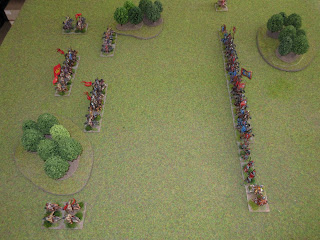After completing the Post Mongol Russians (IV/44), I organised a four-nations test between the newly painted Eastern European armies; Teutonic, Polish, Lithuanian and Russian. Each nation would play in 24 matches, half as the invader, half as the defender. The standard 12 element size army was used and some variation with terrain was needed as three of the participating armies have ‘forest’ as home terrain; here, DBMM Book IV provided a few more options.
The series was done between painting sessions and took about three months to complete. The game board used was 80cm x 80cm, which left 4BW on either flank for a fully extended battleline, however, using a single battleline would meet with disaster. On the whole, the series provided an opportunity to explore interesting deployments and tactics which will be needed for two upcoming historical scenarios.
On a side note, halfway through the series, I became tired of dice flying off the table or disrupting the alignment of troops and the purchase of a dice cup solved this problem. Odd as it may seem, this changed one nation’s fortune for the better. Noted below are the performances of each army with some commentary.
Invader-Defender
Post Mongol Russian (7 wins, 17 losses)
Russia –
Lithuania; 4-1,
4-2, 4-2, 4-0
Russia –
Teutonic; 0-4,
5-2, 4-1, 2-4
Russia -
Polish; 0-4,
0-4, 1-4, 1-4
The composition of the Russian army remained the same throughout the series, 9 mounted and 3 foot troops. Having too few infantry and light horse created difficulties, especially when playing the defender. History has documented how poorly the army of Novgorod performed during the 15th century and this will be covered in a future scenario, the Battle of Shelon.
Later
Polish (15 wins, 9
losses)
Poland –
Russia; 6-3, 4-0, 4-2, 4-2
Poland –
Lithuania; 3-4, 5g-0, 3g-0, 5-3
Poland –
Teutonic; 2-4, 3-4, 4-2, 4-0
The Later Polish were the most enjoyable to use. As invader or defender, the mounted contained a good balance of knights, cavalry and light horse and in many cases they ably out maneuver their opponents. War wagons and militia were used with the latter providing better value. The Teutonic Order proved a tenacious opponent with games lasting 5 or 6 turns.
Lithuania
(16 wins, 8 losses)
Lithuania –
Russia; 4-1, 5-4, 4-3, 6-1
Lithuania –
Poland; 5-0, 5-3, 4-2, 4-3
Lithuania –
Teutonic; 6-3, 5-1, 4-2, 5-0
Losing 7 of their first 8 games against Russia and Poland, I decided to make some changes. Deploying dismounted archers at the start of the game than during the game saved a migraine and investing in a dice cup, made a decided change. The latter was purchased after dice either disrupted the alignment of troops or fell off the table revealing your best die cast. The change was remarkable as Lithuania bounced back to win 14 straight matches. Experiments with deployment proved fruitful and these will be tucked away for our first face-to-face games.
Teutonic
Order (10 wins, 14
losses)
Teutonic –
Russia; 6-2, 5-1, 4-2, 1-4
Teutonic –
Lithuania; 0-5, 0-4, 5-4, 3-5
Teutonic –
Poland; 2-5, 4-2, 1-4, 4-3
Despite their final score, the Teutonic Order are an excellent army to use but do require a long learning curve. The mix of troops, 7 mounted, 5 foot, does require some experimentation to reach a balance when fighting a highly mobile army, such as the Lithuanian. Various deployments were tried, such as evenly split and deployed on both flanks, positioned entirely on one flank, or positioned in the rear.





No comments:
Post a Comment